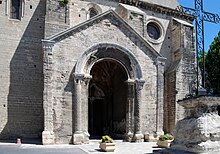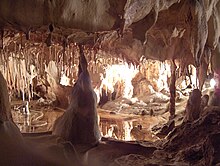Le Thor
| Le Thor | ||
|---|---|---|

|
|
|
| region | Provence-Alpes-Cote d'Azur | |
| Department | Vaucluse | |
| Arrondissement | Avignon | |
| Canton | L'Isle-sur-la-Sorgue | |
| Community association | Pays des Sorgues et des Monts de Vaucluse | |
| Coordinates | 43 ° 56 ' N , 5 ° 0' E | |
| height | 38–111 m | |
| surface | 35.53 km 2 | |
| Residents | 9,071 (January 1, 2017) | |
| Population density | 255 inhabitants / km 2 | |
| Post Code | 84850 | |
| INSEE code | 84132 | |
| Website | http://www.ville-lethor.fr | |
Le Thor is a French municipality with 9071 inhabitants (at January 1, 2017) in the department of Vaucluse in the region Provence-Alpes-Cote d'Azur . It belongs to the canton of L'Isle-sur-la-Sorgue in the Arrondissement of Avignon .
geography
Le Thor is located near the river Sorgue in the west of the department, five kilometers west of L'Isle-sur-la-Sorgue and about 20 kilometers east of Avignon .
Population development
| year | 1962 | 1968 | 1975 | 1982 | 1990 | 1999 | 2008 | 2017 |
|---|---|---|---|---|---|---|---|---|
| Residents | 3186 | 3470 | 4003 | 5023 | 5941 | 6619 | 7916 | 9071 |
|
Source: INSEE
|
||||||||
Attractions
There are some remains of the city walls near the Sorgue, in addition to the city gate, which was redesigned in 1847 to contain a magnificent campanile and clock. The medieval castle that housed the town hall was extensively restored first in 1723 and then in the 19th century. In one of the gardens you can see the statues of Corneille and Molière , made by Louis and Joseph Brian and originally intended to be displayed in front of the Avignon Opera .
Statue of Molière
church
The Notre-Dame-du-Lac church on the banks of the Sorgue was built at the end of the 12th century and has remained very uniform. Similar in plan to the Cathedral of Cavaillon , it shows the progress made in Romanesque building techniques, which can be seen in the use of a ribbed vault . It is also distinguished by the richness of its decoration. A tetramorph adorns the octagonal trumpet dome of the choir and the marble columns of the apse bear capitals decorated with acanthus leaves , eagles and angels . The west and south portals under a vestibule show a wealth of antique ornaments.
Thouzon Hill
- Fortified monastery
To the west of the village of Thouzon (north of Le Thor) a small road leads to a small hill covered in scrubland , dominated by the white ruins of the monastery buildings . In the 11th century there was a priory here , which was soon elevated to the rank of monastery. It was fortified in the 16th century to protect it from looters and abandoned a century later. The Romanesque church of Saint-Marie, the fortified towers and the small Saint-Pierre chapel in the north have been preserved and are being restored by volunteers.
- Stalactite cave
Inside the hill, which testifies to a limestone massif from the Cretaceous period , there is the petrified bed of an ancient underground river. The grotto, hollowed out by the river, with its fistle-shaped stalactites , was discovered by accident in 1902 by quarry workers . It resembles a gallery and is 230 meters long.
Town twinning
Le Thor maintains a partnership with the Alsatian town of Altkirch .
Web links
Individual evidence
- ↑ a b c d Michel Albarède et al .: Vaucluse (= Encyclopédies du Voyage ). Gallimard Loisirs, Paris 2007, ISBN 2-7424-1900-4 , p. 319 .
- ^ Thorsten Droste: Provence (= DuMont art travel guide ). 7th edition. DuMont Reiseverlag, Ostfildern 2011, ISBN 978-3-7701-3927-9 , p. 201 f .





